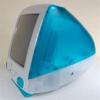What an interesting way to find that out. I guess that's good. Since Hardware is not my specialty I suggest that you post a new topic in the Windows 7 forum where the experts there can provide you better assistance.
I did however want to provide some information on SpyHunter in case you weren't aware. The following information is being provided with permission from quietman7.
SpyHunter by Enigma Software Group (ESG) is a program that was previously listed as a rogue product on the Rogue/Suspect Anti-Spyware Products List because of the company's history of employing aggressive and deceptive advertising. It has since been delisted but Enigma still engages in deceptive advertising which violates several consumer protection laws in many states. Newer versions of SpyHunter apparently install it's own "Compact OS" and uses Grub4Dos loader to execute on boot up. The user no longer sees the normal Windows boot menu but instead sees the GRUB menu. For some folks this has resulted in SpyHunter causing a continuous loop when attempting to boot and other issues.
AV-Test has not been able to include SpyHunter in their comprehensive testing analysis which would reveal how SpyHunter compares to anti-spyware competitors in terms of protection, detection, repair and usability. The reason for this is that the publisher, Enigma Software, has not been cooperative in submitting SpyHunter for testing at AV-Test...most likely due to the program's ineffectiveness and high rate of false positives.
While there are mixed reviews for SpyHunter, many customers have reported deceptive pricing, continued demands for payment after requesting a refund, lack of adequate customer support, removal (uninstall) problems and various other issues with their computer as a result of using this product. For example...most users are not aware that when purchasing SpyHunter, they have agreed to a subscription service with an automatic renewal policy. This information is in fine print at the bottom of the SpyHunter Purchase Agreement.
SpyHunter is a 6 month subscription spyware detection/removal service. By making this purchase, customers agree, for their convenience, to be autorenewed every 6 months in order to receive ongoing spyware protection, definition & program updates, custom fixes to their specific spyware problems, and advanced technical support from our Spyware-Helpdesk. You will receive an e-mail notification to opt-out, if you do not wish to be autorenewed.
You may want to read some of the user comments posted on the Complaints Board: Enigma Software Group Spyhunter Complaints & Reviews.
Further, when searching for new malware or malware removal assistance (and removal guides) on the Internet, it is not unusual to find numerous hits from untrustworthy and scam sites which misclassify detections or provide misleading information. This is deliberately done more as a scam to entice folks into buying an advertised fix or using a free removal tool. SpyHunter (SpyHunter-Installer.exe) is one of the most common "so-called" removal tools pushed by these sites.
However, SpyHunter is not considered malware or rogue security software so security vendors do not target it for removal. Those security vendors which have tried in the past received threats of legal action for attempting to do so or agreed to legal settlements as a result of litigation brough forth by Enigma Software. See this Table of Threats and Demands which identifies Enigma as one of the companies to make repeated "Cease and Desist" demands against those security vendors which detect, remove, and/or criticize their product.
In my opinion SpyHunter is a dubious program which is not very effective compared to others with a proven track record and I would not trust all the detections provided by its scanning engine. If you have downloaded and scanned with SpyHunter, any detection results should be viewed with suspicion. My personal recommendation would be to remove the program and replace it with a trustworthy alternative such as Malwarebytes Anti-Malware or Emsisoft Anti-Malware.
SpyHunter4 creates the following scheduled task which should be disabled/removed.
SpyHunter4Startup "C:\Program Files\Enigma Software Group\SpyHunter\Spyhunter4.exe" /s
If you have AutoRuns or CCleaner installed, you can also use those tools to disable and remove tasks.
Note: Some users have reported that you may need to open Windows Explorer, navigate to the following location, look for and delete a SpyHunter related file named SHSetup.exe before uninstalling from Programs and Features (Add/Remove Programs) in Control Panel.
-- XP: C:\Documents and Settings\<user name>\Local Settings\Temp
-- Vista, Windows 7/8: C:\Users\<user name>\AppData\Local\Temp
If the suggested removal methods fail...then you need to Contact ESG Technical Support Team and submit a ticket.
* How to Submit a Customer Support Ticket
Submitting support tickets is only for customers who purchased ESG products. If you are not a paid customer or not able to logon to their member’s section, you can try contacting ESG through the Inquiries & Feedback page.
I also suggest you write about your issues on the Complaints Board: Enigma Software Group Spyhunter Complaints & Reviews and send them an email. If you read through those comments, you will notice that Enigma Representatives respond to those making complains.
I am the Vice President of Technical Support and Research at Enigma Software Group. I read the post above and I would like to let you know that we have an email specifically for complaints. You or anyone can submit a complaint and I can assure you that we will find a suitable solution for any problem that is related to SpyHunter or to our service. If you have any questions or complaints, please send us an email to [email protected]. I personally read all emails from that account. At Enigma Software Group, we work hard to maintain the best level of service and make sure that every customer becomes a satisfied customer.
Regards,
Alec Malaspina
Enigma Software Group USA, LLC.
I have referred several other members to follow the above instructions and all were successfully assisted by ESG Tech Support with removing SpyHunter.

 This topic is locked
This topic is locked








![Laptop will only boot to black screen with cursor [Solved] - last post by Essexboy](https://www.geekstogo.com/forum/uploads/profile/photo-177837.gif?_r=1396965007)








 Sign In
Sign In Create Account
Create Account

